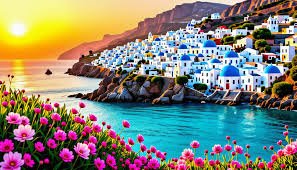
Discovering the Magic of Santorini: A Greek Island Escape
Page 1: Introduction to Santorini
Santorini, one of Greece’s most iconic and beloved islands, is located in the Aegean Sea. Famous for its stunning sunsets, whitewashed buildings, blue-domed churches, and dramatic cliffs, this island is a dream destination for travelers worldwide. Whether you’re seeking relaxation on pristine beaches, a taste of local culture, or breathtaking views, Santorini has it all. This paradise is a perfect blend of history, natural beauty, and a Mediterranean lifestyle that draws visitors to its shores year after year.
Geography and Climate
Santorini is part of the Cyclades archipelago and was formed by a volcanic eruption thousands of years ago. The island is known for its unique crescent shape, with steep cliffs surrounding the caldera, or volcanic crater, offering panoramic views of the sea. The climate is Mediterranean, with hot, dry summers and mild winters. This makes it an ideal year-round destination, with summer temperatures often reaching into the 80s and 90s Fahrenheit.
Page 2: Attractions and Activities
1. Caldera Views
The centerpiece of Santorini’s charm is its caldera. The cliffs around the caldera offer the best views of the island’s picturesque towns, especially from Oia. A visit to the caldera is a must for anyone wanting to see the true beauty of the island. There are several ways to explore the caldera, including taking a boat tour, which gives you an up-close view of the volcanic island and the clear blue waters of the Aegean Sea.
2. Oia – The Sunset Capital
Oia is perhaps the most famous village on Santorini. It is renowned for its whitewashed buildings, narrow streets, and incredible sunsets. Visitors flock to Oia each evening to witness the sun dipping below the horizon, painting the sky with hues of orange, pink, and purple. The village is also filled with charming shops, cafes, and restaurants offering traditional Greek dishes, making it the perfect spot for an evening stroll.
3. Fira – The Capital
Fira is the capital of Santorini and offers a bustling atmosphere with shopping, dining, and nightlife. The town is perched on the edge of the caldera, providing amazing views. Fira is also home to the Archaeological Museum of Thera, where visitors can learn about the island’s history, including its ancient ruins.
Page 3: The Beaches of Santorini
Despite its volcanic history, Santorini is home to some striking beaches. While many beaches in Santorini are not the traditional soft sandy shores one might expect from other islands in Greece, they each offer something unique.
1. Kamari Beach
This black-sand beach is one of the most popular in Santorini. Located on the eastern side of the island, Kamari is known for its clear waters and lively atmosphere. It’s perfect for sunbathing, swimming, and enjoying the nearby cafes and restaurants that line the promenade.
2. Red Beach
Known for its dramatic red-hued cliffs and sand, Red Beach is a must-see for those visiting Santorini. It’s located near the ancient site of Akrotiri, so visitors often combine a trip to the beach with a visit to this historic site.
3. Perissa Beach
Perissa is another black-sand beach, but it’s quieter than Kamari. It’s perfect for those who want to relax and enjoy the clear waters without the crowds. The beach has a laid-back vibe, with several beachside tavernas offering fresh seafood.
Page 4: Santorini’s History and Culture
1. Ancient Akrotiri
The ancient city of Akrotiri is one of the most significant archaeological sites in Greece. This Minoan city was buried by a volcanic eruption around 1600 BCE, and its ruins have been preserved remarkably well. Walking through the excavated site gives visitors a glimpse into life on Santorini thousands of years ago.
2. The Museum of Prehistoric Thera
Located in Fira, this museum showcases artifacts from the island’s ancient history, particularly from the excavations at Akrotiri. Visitors can explore pottery, tools, and frescoes that depict the life and culture of the Minoans, who inhabited Santorini before the eruption.
3. Wine Culture
Santorini is famous for its wine, especially its white wines made from the Assyrtiko grape. The island’s volcanic soil provides unique conditions for wine cultivation. Wine tours are a popular activity for visitors, and many local wineries offer tastings, allowing guests to sample a variety of wines while enjoying the beautiful landscape.
Page 5: Practical Information for Travelers
How to Get There
Santorini is easily accessible by air and sea. The island has its own airport, Santorini National Airport, with regular flights from Athens and other major cities in Europe. Ferries also run frequently between Santorini and other Greek islands, making it a great base for island hopping.
When to Visit
The best time to visit Santorini is in the spring (April to June) and fall (September to November). These seasons offer pleasant weather and fewer crowds than the summer months. While summer is the peak tourist season, it is still a great time to visit for those who enjoy the lively atmosphere and warm weather.
Where to Stay
Santorini has a wide range of accommodations, from luxury hotels and resorts with caldera views to more budget-friendly options in towns like Fira and Kamari. For a unique experience, many visitors choose to stay in traditional cave houses carved into the volcanic rock, which offer stunning views and a distinctive atmosphere.
Final Thoughts
Santorini is a destination that offers something for everyone – from history enthusiasts and beach lovers to those seeking the perfect sunset. Whether you’re savoring local wines, exploring ancient ruins, or simply relaxing by the sea, Santorini’s magic is undeniable. It’s a place where beauty, history, and culture come together to create an unforgettable experience. A visit to this magical island will leave you with memories to last a lifetime.
